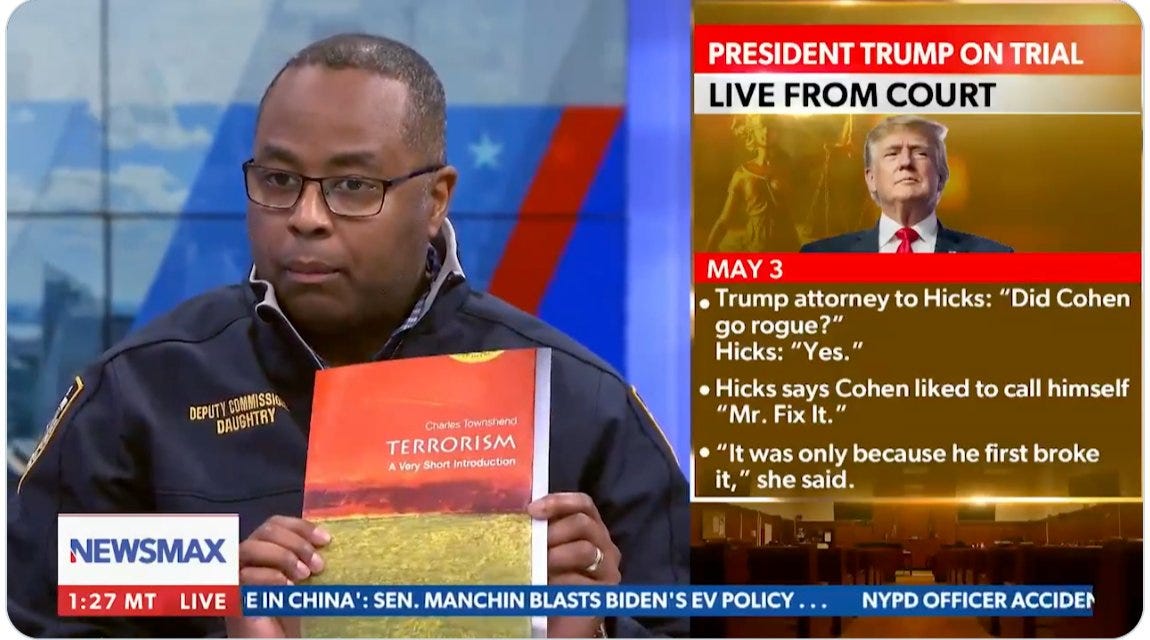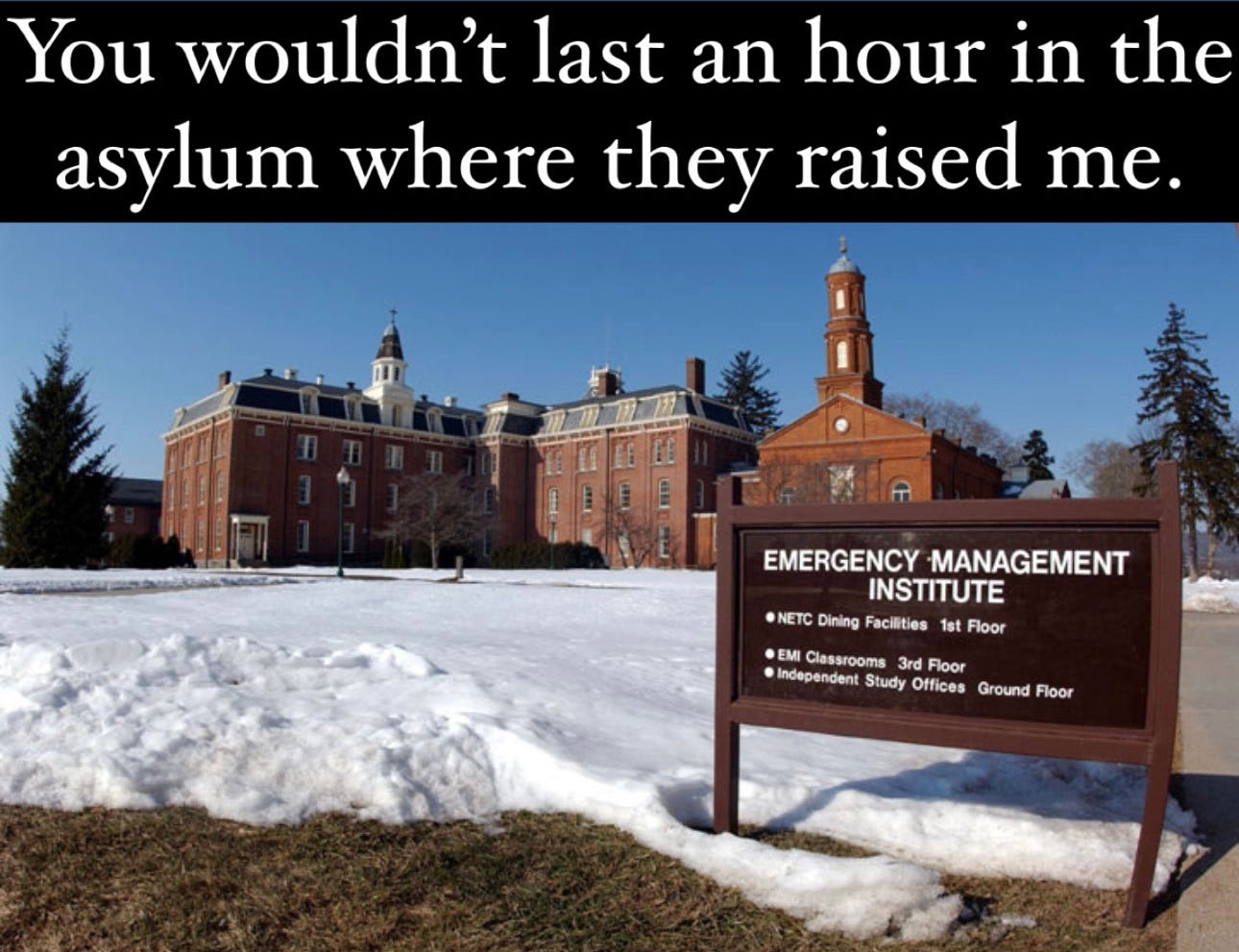This newsletter is a compilation of recent disaster ~things~ that I think are cool, important, or otherwise of interest to people who are intrigued with disaster (broadly defined).
There’s a little something for everyone!
Hello! Hello!
This newsletter is late. I’ve been living in a tent for two weeks (for disaster reasons, not protest reasons). I’m running off a hotspot and cold medicine has become one of my main food groups. So, bear with me.
While I would love to share all the wildfire recovery/mitigation work that my students and I have been doing in California with Team Rubicon, I, unfortunately, live in a country that is helping to fund a genocide. So, we need to dedicate our attention to that.
While I normally write this newsletter through the lens of a disaster researcher, today, my job as a professor is more important – though they are, of course, inextricably intertwined.
They Want Our Students Dead
Years ago, there was an afternoon when I thought my students and I were dead. I don’t really want to tell this story, but I think you need to understand what this country has come to expect professors (and teachers) to do.
One of my students, amid a mental health crisis, threatened the life of another student in my class. Despite my many requests, no help came. In the end, it was just me – alone – standing between my classroom of students, and a person who I believed had a gun.
There was no question from me, or anyone else, that I would stand there and do everything I could to keep them all safe. In the end, some former de-escalation training I had taken, worked. I calmed the student down and was able to get them help. Later I learned, too much relief, that he had not gone home to get his gun and that we had actually been okay.
In a country where politicians refuse to pass meaningful gun control, this has become our daily reality – checking your phone throughout class in case there is a shelter-in-place order, making mental notes of who has mentioned having access to guns, jumping when there’s a loud bang on campus.
For me, the right to education is sacred, and the relationship between student and teacher is cardinal. Students are entrusted to us. We keep them safe and heard, foster their intellectual development, and encourage their personal grow.
As an emergency management professor and disaster researcher (and a person with a conscious), I have watched the escalation in Gaza closely. In our terms, decades of apartheid and occupation produced the conditions for the Oct 7th attack which was then used as justification for a catastrophic genocide and emerging famine.
Israel has strategically destroyed Gaza’s Universities – what Professor Karma Nabulsi has termed ‘scholasticide’. The Intercept noted that, “within the first 100 days of its war on Gaza, the Israeli military systematically destroyed every single university on the strip.” The UN reports that in Gaza 5,500 students (all ages) have been killed by Israel along with 95 university professors. Education is central to Palestinian culture and, of course, a precursor to revolution. It is not surprising that Universities were among the first to be eliminated.
Now I am watching with deep admiration the brave work of students across the U.S. who are organizing to demand their universities to divest from the war in Gaza. I am so proud to see the precision with which they are articulating their beliefs. They have done the work of educating themselves and each other. Some encampments have libraries, named for Refaat Alareer, a Palestinian professor and writer who was killed by the IDF.
I am in awe of the care they have for one another in creating a safe and comforting space for all protesters, including Jewish students. This care has manifested through creating physically safe spaces for religious services within the encampments, making meals that adhere to various dietary needs, and defending themselves against violent counter-protestors.
I see the support from surrounding communities in the delivery of supplies and raising of bail money. There are parents who have come to protest alongside their kids, and long-time activism strategists who are sharing their experience and knowledge in how to be successful. I see in their strategy the lessons and traditions of the Civil Rights Movement, anti-Vietnam protests, anti-McCarthyism, the anti-apartheid movement, Black Lives Matter, and Standing Rock come back to life. Universities have long been the home of protests and dissent, and students have long been the ones to lead the way.
I also see a generation of professors trained to protect their students against people with guns, now facing down the police. Many of the professors I admire most have been on the frontlines. Annelise Orleck, a history professor and former head of their Jewish Studies program was thrown on the ground by police and arrested, as was Nöelle McAfee, the head of Emory’s Philosophy Department. I recommend following Prof. Steven Thrasher who has been covering the protests on Twitter. Not only have they joined in the protests of genocide themselves but have also continued their job of student care, growth, and protection. They exemplify, to me, what it means to be an educator and scholar-activists.
I am overwhelmed with the path American universities have been pulled down by divisive and immoral administrators. While the tension between administrators and faculty is nothing new, calling police in riot gear to slam your faculty to the ground, shoot them with rubber bullets, and arrest them feels irreparable. Say nothing of doing this to your students who are now using the very tactics we have taught them to protect themselves from active shooters to protect themselves from violent counter-protesters and police. How can parents send their kids back to school when they’ve pointed snipers at them from the roof?
The speed at which University administrators decided peaceful protests should be met with militarized police forces left my head spinning. Although, my surprise is only in that the police have not yet killed anyone. Disasters repeat themselves and another Kent State feels inevitable.
And, of course, there is another way. Brown University, Evergreen State College, and Rutgers University have taken the approach of meeting with student organizers to hear their demands. (BTW – it’s completely reasonable for students, alumni, and faculty to have a say in what their institution invests in.) There is a way forward here that addresses the extremely valid concerns of protestors and does not bring about more violence. The administrators know this but have actively chosen the route which harms their faculty and students.
I just keep thinking that they want our students dead. They want them quiet. They want control over the classrooms – the content we teach and us. They want our institutions to be complicit. Some politicians, like this New York City councilwoman, have said they literally want our students dead.
These students represent a better future. They represent all that is good and hopeful about the future. Universities are problematic institutions, but they are places where new ideas — and challenging ideas — can emerge. Israel’s destruction of Gaza’s universities is a visceral reminder of the power of education; both in it being among the first to be attacked and among the first to fight back. They are a threat to those in power which is why Israel destroyed them first and why President Biden is supporting the use of violent force against students.
The arc of the moral universe does not bend itself.
Certainly, this entire situation overlaps with emergency management in a thousand different ways. For now, I would draw your attention to this incredible piece by Mary Annaïse Heglar which draws parallels between the 1927 Mississippi River flood and Gaza.
To end, I want to provide what will be (for the readers of this newsletter in particular) a moment of levity. The NYPD Deputy Commissioner went on TV for a real “ah-hah! See the protestors are terrorist! They’re reading a book about terrorism!” moment after finding an Intro to Terrorism book in one of the encampments that most of us probably have on our bookshelves.
It is worth noting that there is often deep stupidity that underlies brutality.
MEME Break
I was told there would be a riot if there wasn’t a Taylor Swift meme included in this newsletter.
Maui Recovery
The first part of the Maui Fire report was released this month. After 101 people were killed in the fire, there were immediate calls for an investigation. This particular report was put together by the Fire Safety Research Institute. You can tell because it leans heavily towards fire and not emergency management. This is one of my biggest critiques of these types of reports – similar to NTSB. Of course, the hazard element is important but so often the actual failures are in the response. The “lessons learned” approach is problematic for many reasons but perhaps most of all is that we’re not even compiling a list of the right so-called lessons learned!!
You can read the full report here and review the minute-by-minute timeline here. It’s a lot to go through. I read through the report and skimmed the timeline (y’all it’s 12,000 lines of data and I actually do have a full-time job that is not this newsletter).
The End Bits
I would love it if you’d forward this to your friends, post on social media, and undertake any other form of newsletter sharing you deem appropriate.
In case you signed up for this newsletter without knowing who I am (a bold choice!) you can read my book Disasterology: Dispatches From The Frontlines of The Climate Crisis to catch up! You can read a USA Today review here, order it here, or get it as an audiobook here. You can also find more from me on my blog, listen to this episode of Ologies, or follow me on Twitter and Instagram where I impulsively narrate my every thought.
Finally, this newsletter is ~FREE~. I plan on keeping it that way because eliminating barriers to disaster knowledge is important. However, I’ve created a “paid subscriber” option for $5 a month or whatever you’d like to give if you’re interested in supporting this work.






Thank you, Samantha.
Thank you for this.